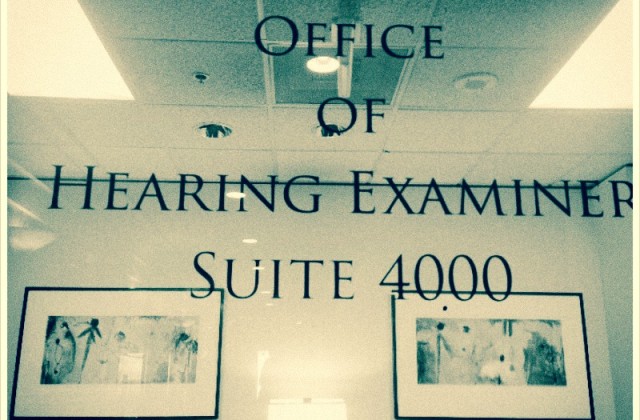DPD: We Didn’t Reduce Housing Capacity, but the Reduction Was Minor
Last week Smart Growth Seattle had it’s day in court with the City’s Department of Planning and Development (DPD). Well, it wasn’t court exactly, but the Hearing Examiner. The City had tried to throw our appeal of DPD’s and Councilmember Clark’s significant reduction of housing capacity in the city’s low-rise zones (Councilmember Clark continues to maintain that there is “no legislation,” but DPD staff acknowledged that, indeed, there is legislation on the table). But the City’s motion, based on the idea that Smart Growth Seattle is a “creature of the internet” was denied. We made what I think was a compelling case that the City failed to do appropriate quantitative review of the environmental impacts of the reduction in housing capacity in the proposed legislation.
To win, we don’t need to prove what the environmental impacts might be, but that they were dismissed and not properly considered when putting the legislation together.
Our case:
- The proposed legislation is a significant loss of housing capacity;
- With less supply, there will be higher prices;
- New people trying to find housing in the low-rise zones will likely to go elsewhere, and possibly outside the city, for housing;
- DPD didn’t consider this or conduct appropriate environmental review to account for reduced housing supply and fewer housing choices;
- DPD and Councilmember Clark were motivated to change the low-rise zones based on neighborhood complaints that new housing was ‘out of scale’ with other buildings;
- DPD chose to address the building size issue by reducing density;
- DPD chose their examples of ‘bad’ development from controversial projects selected by angry neighbors; and
- The City need to complete additional quantitative review of possible impacts before they, with the wave of a hand, say there aren’t any.
The City’s case:
- DPD never thought there would be as much density in the low-rise zones when they made changes in 2010;
- DPD expected a density of 1 unit per 1,800 square feet, but got 1 unit per 1,250 square feet;
- This outcome wasn’t a ‘mistake’ by DPD however;
- The city can take density back if it wants to, otherwise we’ll get too much
- The reduction in housing was ‘minor’ and ‘not significant;’
- There really isn’t a reduction in capacity; and
- The problem will go away because the legislation simply undoes what happened in 2010, essentially putting density limits where DPD had originally intended them to be.
This last point, that the reduction in housing capacity was small and not worth a quantitative environmental review but also didn’t happen, was the strangest argument offered. Under cross-examination, Geoff Wendtland consistently said the impact was minor, but denied that there was a reduction in housing capacity. When asked repeatedly, “will this result in less capacity in the low-rise for housing,” Wendtland would say things like, “I wouldn’t say that.” And when asked directly, “could there be more capacity after the legislation,” Wendtland said, “yes, if people build more densely.” The City wants it both ways, suggesting it didn’t take housing away, and the housing it did take away wasn’t all that much. And the code controls density, except when it doesn’t.
On it’s face the City’s argument was strained and relied on calling the possible environmental impacts “speculative” and “too difficult to analyze.” But isn’t all environmental impact challenging to review and analyze? The truth is that most environmental review has become boilerplate stuff; no developer or project reviewer would ever do anything that would trigger a finding of environmental impact. In other words, everyone knows what the rules are and just follows them.
Except in this case the City specifically calls out an impact, and then says it’s minor. It’s like a vendor saying he’s going to charge you more money for the hot dog you just ordered, but when asked, “how much more,” the vendor says, “Oh, it will be minor and not significant.”
One last point; what’s also clear is that while the neighborhood made the greatest noise about building height bulk and scale, the legislation does absolutely nothing to change that. In essence, their proposal will simply reduce the number of available units while keeping buildings the same height. So, nobody wins. Angry neighbors will still push for what amounts to a downzone, and DPD staff will continue to comply, saying, “pay no attention to what we passed in 2014, it was denser than it should have been.
In the end, the City has an obligation to be transparent when it carries out the whims of angry neighbors: they’re making it worse for people who want to move to our city to share the great things we have here. We think we made an excellent case.


